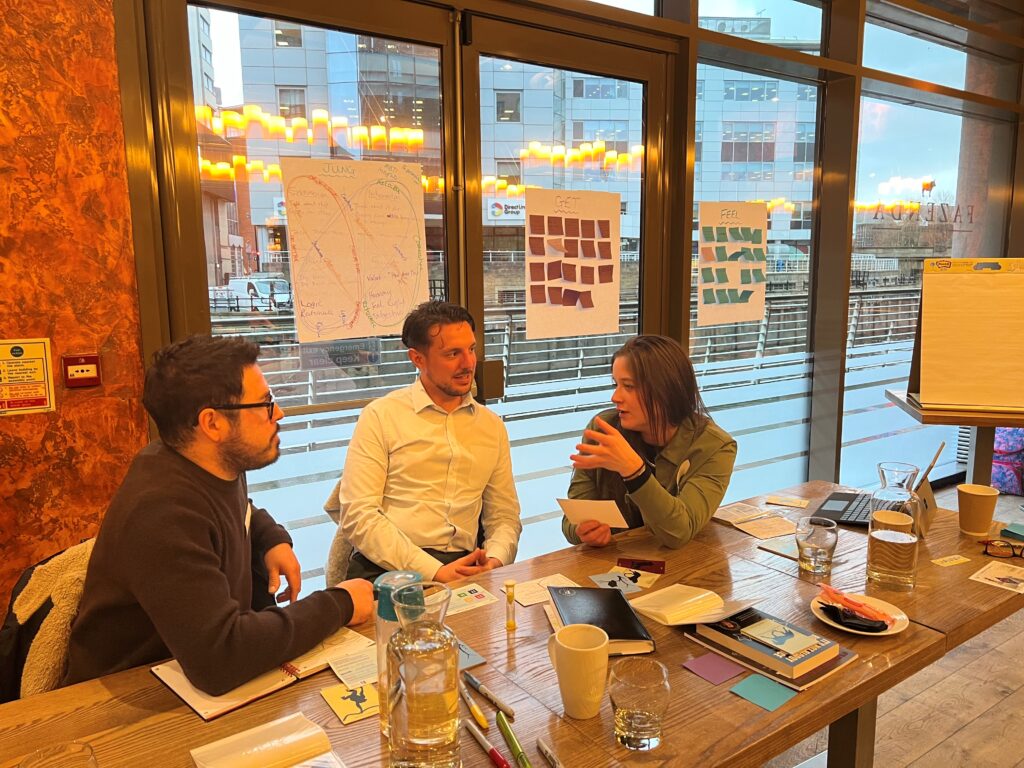Five Flavours of “it”: A Neuroscience Take on Imposter Thinking
Applying ‘Get and Feel’ Beyond Face-to-Face Training
We hand out two Post-it notes: one purple and one teal.
This practice isn’t just a quirky ritual; it’s grounded in neuroscience and psychology

Why ‘Get and Feel’ Works
Priming the Brain for Learning
When individuals articulate what they aim to gain from a session, they engage in a process known as goal setting.
This activates the brain’s executive functions, enhancing focus and information retention. By defining clear objectives, participants are more likely to recognise and internalise relevant information, leading to more effective learning outcomes. We make the learning salient.
When we tell our brain to look out for something it does – ever noticed there are so many more cars on the road that match yours as soon as you get a new one in a new colour? It’s called frequency bias. There were the same number of cars of that colour on the road before, but they passed our brains by.
We can use frequency bias to our advantage to make any training more relevant. If we think about what we want to GET from a session and what is most relevant to us at work right now, our brains will look for opportunities to get that GET.
And it might be insights that had went unnoticed without ‘priming’ the brain to look out for those connections.
Given that training takes participants away from their day job, there is an opportunity cost – the things they have not done as a result of being in the room. I use GET as a simple way to enhance ROI.
Thinking about what we have come to GET (instead of your usual work being done) and making the GET as tangible as possible and as connected to what is going on at work right now, means that trade off between what you could have done to add value to the business and what GET from the room instead is simply, but powerfully, recognised.
Harnessing Emotional Motivation
Asking participants how they want to feel taps into the emotional aspects of learning. We tell every participant this simple neuroscience-backed fact as we begin our training:
“Emotions drive behaviour”
Emotions significantly influence motivation and memory. By envisioning a desired emotional state—such as confidence or clarity—individuals are more likely to engage in behaviours that lead to them feeling those feelings at the end of the session.
This process leverages the brain’s reward system, reinforcing positive learning experiences. Our brains will look for reasons to be confident about a topic if we tell it to look for those reasons in advance.
And if you tell yourself you want to feel confident with a topic, this will enhance your attention to looking for things to increase confidence. If you start to feel your FEEL, you will enhance your changes of getting your GET!
Closing The Session
Measuring the ROI of training is the holy grail, right?!
We have a really simple way of measuring success. At the end of session, we simply ask delegate to go back to the flipchart with the Purple and Teal post-its and review them.
If they got their GET and feel their FEEL, they remove the post it. If they didn’t, they put a score out of 10 on it to show how close they got. This means we can offer up a book chapter to move understanding to an 8 to a 9.
Or suggest some Real-Life Practise that would help.
The Psychology of Purple and Teal
Purple: Stimulating Creativity and Strategic Thinking
Purple has long been associated with creativity, wisdom, and ambition. In colour psychology, it’s believed to stimulate problem-solving and imaginative thinking.
Using purple Post-its for the ‘GET’ aspect subtly encourages participants to think strategically and creatively about their goals.
Teal: Evoking Calmness and Emotional Balance
Teal combines the calming properties of blue with the rejuvenating aspects of green. It’s often associated with emotional balance and tranquility. By using teal Post-its for the ‘feel’ component, we prompt participants to consider their emotional well-being, fostering a holistic approach to learning. However mostly we make a joke to break the ice.

“You will remember Teal for FEEL – which means everyone will use the same post-its for the same flipchart, and that will look better on Instagram!”
Someone still usually gets in ‘wrong’ in a room of 20 people – but once again our mantra of “If you can’t hide it, feature it serves us well. Everyone remembers and looks to GET them their GET as it looks out of place on the Teal wall!
Applying ‘Get and Feel’ Beyond Face-to-Face Training
Firstly this works just fine in a chat function. You don’t get the benefit of colour, but it’s a quick and easy way to get the training warmed up.
This technique isn’t limited to training sessions. In meetings, initiating with ‘GET and FEEL’ can align expectations and improve outcomes. For instance, if someone comes to a meeting to resolve a specific issue (their ‘GET’), but it’s not on the agenda, addressing this upfront can prevent frustration.
Similarly, understanding desired emotional outcomes can guide the meeting’s tone and approach. If someone states they want to FEEL less frustrated, a facilitator knows they are currently feeling frustrated upfront and can navigate that before it leaks out and derails, and a short meeting becomes a long one filled with venting that emotion.
Conclusion
The ‘GET and FEEL’ method is a simple yet effective tool to enhance engagement, focus, and emotional intelligence in various settings. By consciously setting objectives and emotional intentions, individuals are better equipped to achieve meaningful and satisfying outcomes.
Tags:

.jpg?width=500&height=500&name=Headshots_Dulcie%20(1500%20x%201500%20px).jpg)